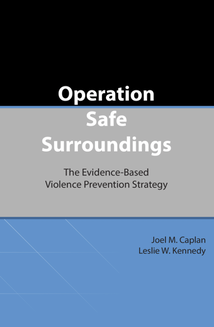|
Operation Safe Surroundings (OpSS) is a simple practical playbook for making RTM work in your jurisdiction.
This evidence-based violence prevention strategy will help you reduce crime and enhance public safety. OpSS is an effective and sustainable approach to problem-solving that:
|
ACTION is a pragmatic focus on Assessment, Connections, Tasks, Interventions, Outcomes and Notifications. ACTION is a standard procedure for risk-based policing that can be replicated within and across various jurisdictions and crime problem types. ACTION allows for customization based on the problem-at-hand. Meaningful and actionable information is achieved with this risk management agenda.
Sustainability and Community Engagement
Two types of ACTION Meetings may occur: 1) Police ACTION Meetings, and 2) Community ACTION Meetings.
The Police ACTION Meeting is comprised of officers from the municipal police department as well as other invited law enforcement or security-related partners who operate within the jurisdiction and who can be privy to sensitive intel. Participants may include the Chief, Deputy Chief, Captains, Lieutenants (District Commanders), the homeless outreach officer, the public relations spokesperson, and the crime analyst, among others. This “police taskforce” meets monthly to assess the risk terrain model’s predictions to-date and to propose ways to govern crime risks from law enforcement and policing perspectives. Consensus is reached on activities that could be feasible and likely effective at addressing the most pressing crime problems.
The Community ACTION Meeting is a multi-stakeholder event, and comprises members of the police taskforce as well as city officials and other community leaders. This may include representatives from the Mayor’s office, city council, and various city departments, such as Planning and Development, or Public Works; representatives of the mercantile associations, social and human service agencies, faith-based organizations, and local non-governmental organizations; school officials; business/store owners; and county and state executives. This “multi-stakeholder taskforce” reviews the risk-based policing initiative and proposes risk governance activities from a broad public perspective. Community ACTION Meetings were not open town hall style meetings where grievances get aired. They are invitation-only working meetings where risk assessments are shared and groundtruthed, data are managed, and initiatives to reduce risks are proposed and committed to by various stakeholders. Buy-in and support for the risk-based policing initiative is routinely obtained from members of the Community taskforce.
RTM with ACTION proves to be transparent because analytical inputs are vetted by community stakeholders; analytical products are distributed for comment at ACTION Meetings; and, well-informed community stakeholders enthusiastically work with police to design risk reduction strategies. Stakeholders at ACTION Meetings ensure that the risk analysis and related intervention strategies would be acceptable in the context of police practices and community relations. All parties realize that their unique points of view could have value towards achieving the shared goal of public safety.
Police still enforce the law and investigate crimes. But with ACTION, community members have a clear and measurable role to play in crime prevention. When police share the burden of ensuring public safety with community stakeholders, these people become partners to help solve existing crime problems.
With wide-ranging buy-in, reliable and valid risk assessments methods, comprehensive resource deployment plans, reliable data management procedures, and an established meeting schedule, risk-based policing with RTM and ACTION puts cities on track for effective, transparent, and sustainable crime prevention.
The Police ACTION Meeting is comprised of officers from the municipal police department as well as other invited law enforcement or security-related partners who operate within the jurisdiction and who can be privy to sensitive intel. Participants may include the Chief, Deputy Chief, Captains, Lieutenants (District Commanders), the homeless outreach officer, the public relations spokesperson, and the crime analyst, among others. This “police taskforce” meets monthly to assess the risk terrain model’s predictions to-date and to propose ways to govern crime risks from law enforcement and policing perspectives. Consensus is reached on activities that could be feasible and likely effective at addressing the most pressing crime problems.
The Community ACTION Meeting is a multi-stakeholder event, and comprises members of the police taskforce as well as city officials and other community leaders. This may include representatives from the Mayor’s office, city council, and various city departments, such as Planning and Development, or Public Works; representatives of the mercantile associations, social and human service agencies, faith-based organizations, and local non-governmental organizations; school officials; business/store owners; and county and state executives. This “multi-stakeholder taskforce” reviews the risk-based policing initiative and proposes risk governance activities from a broad public perspective. Community ACTION Meetings were not open town hall style meetings where grievances get aired. They are invitation-only working meetings where risk assessments are shared and groundtruthed, data are managed, and initiatives to reduce risks are proposed and committed to by various stakeholders. Buy-in and support for the risk-based policing initiative is routinely obtained from members of the Community taskforce.
RTM with ACTION proves to be transparent because analytical inputs are vetted by community stakeholders; analytical products are distributed for comment at ACTION Meetings; and, well-informed community stakeholders enthusiastically work with police to design risk reduction strategies. Stakeholders at ACTION Meetings ensure that the risk analysis and related intervention strategies would be acceptable in the context of police practices and community relations. All parties realize that their unique points of view could have value towards achieving the shared goal of public safety.
Police still enforce the law and investigate crimes. But with ACTION, community members have a clear and measurable role to play in crime prevention. When police share the burden of ensuring public safety with community stakeholders, these people become partners to help solve existing crime problems.
With wide-ranging buy-in, reliable and valid risk assessments methods, comprehensive resource deployment plans, reliable data management procedures, and an established meeting schedule, risk-based policing with RTM and ACTION puts cities on track for effective, transparent, and sustainable crime prevention.

